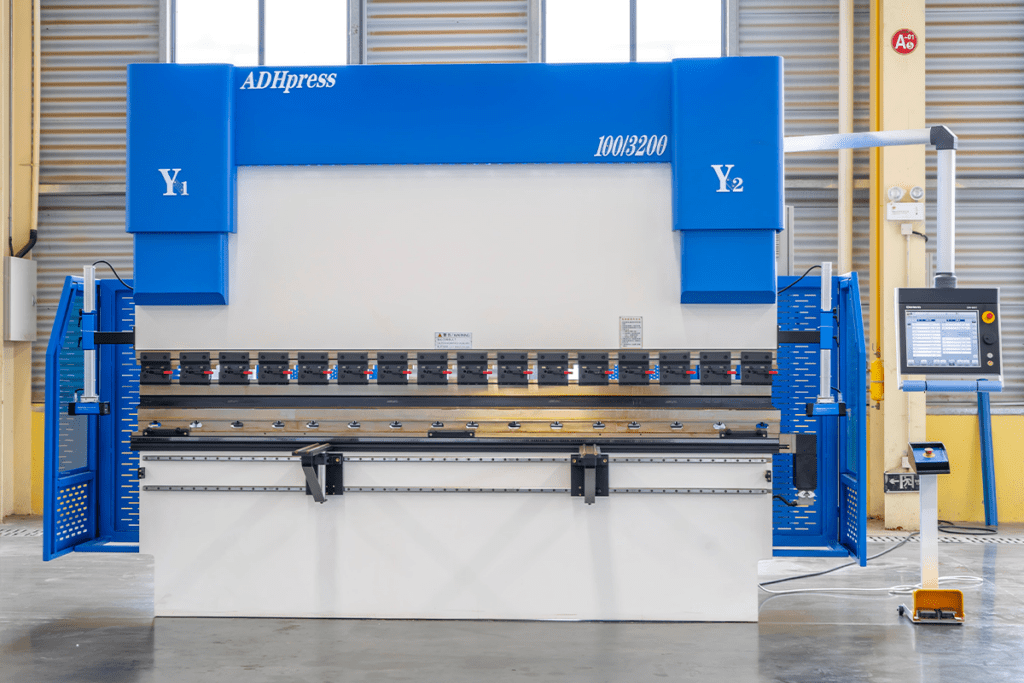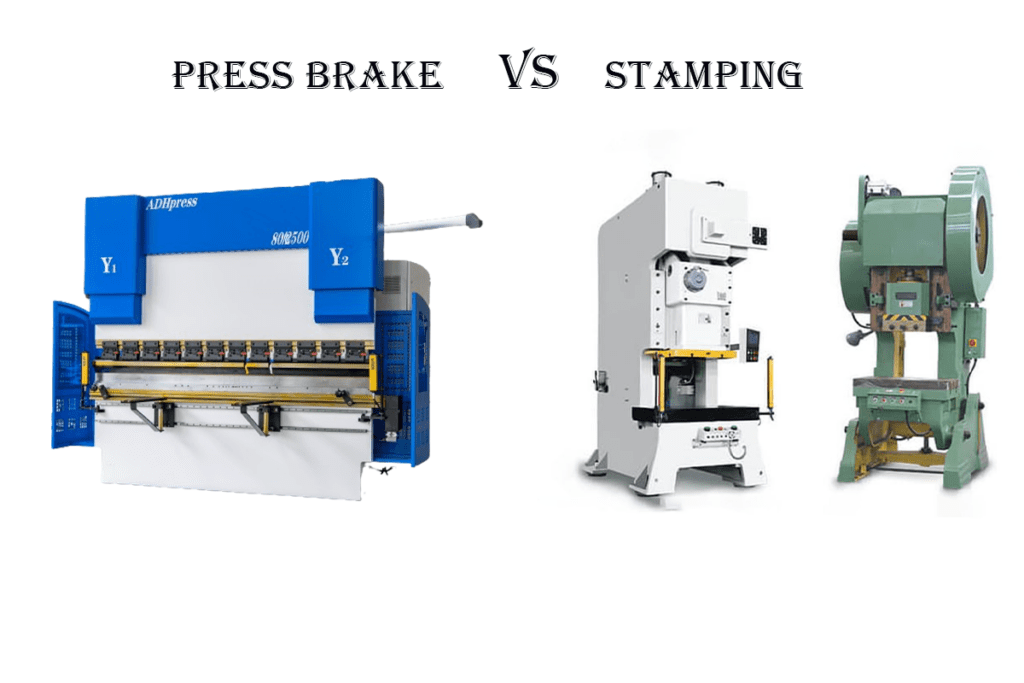Metal forming is one of the fundamental processes in manufacturing. It uses various mechanical methods to change the raw metal material into various shapes and provide necessary components for many industries. In metal fabrication, the main process includes press brake and stamping. The press brake can achieve the partial bending and deforming of the material, which is used for straight sheets or slice materials. Via simple operation, an ideal bending shape can be produced. This costs a little and is very convenient for simple and single parts. The stamping adopts the integral forming principle, which simultaneously moves up and down through the die and stamps the material into the required forms. This brings higher accuracy and achieves more complex three-dimensional modeling. However, the cost may be high. Choosing the way of proper metal forming is closely related to the success of products. Our passage aims to make a comprehensive comparison between the two main metal forming processes, brake and stamping, which can offer a reference for readers to choose the ideal process. The press brake is a machine used to bend metal sheets. It can be bent through clamping the workpiece between the matched top punch and bottom die. The bending process involves two C-shaped frames, which are made up of the side of the press brake and can be connected to the bottom workbench and top movable beam. The bottom dies are installed on the workbench, and the top punches are installed on the upper beam. The press brake features two main types: hydraulic and electronic. The hydraulic press brake utilizes the bending force produced by hydraulic cylinders and pumps. It is driven by the mechanism to produce reliable bending. The electronic press brake adopts servo motors and advanced digital control devices. It can provide programming bending sequences and higher accuracy. The press brake has multiple advantages: Also, there are some disadvantages: The press brake is widely applied in many manufacturing. The automotive relies on it to form the body components and chassis. The electrician manufacturing relies on it to bend metal panel cabinets. Also, the press brake can be applied to the HVAC, electronics, and aerospace industries to shape ductwork, enclosures, and structural components. Its flexibility makes it a versatile solution for metal manufacturing. Stamping is an essential process in metal fabrication, which refers to forming metal parts by pressing or "stamping" them between top and bottom dies. This involves a high-speed metal forming process that uses a punch press, a machine equipped with dies to operate a punching operation. There are various types of press, and each type is customized for specific tasks; the common use is as follows: Mechanical press: it uses a mechanical flywheel to store the energy and transform it to the punch, then be operated when transported to the die. Hydraulic press: it uses hydraulic oils and a series of hydraulic cylinders to produce compressor force. Servo press: this innovative machine uses servo motors to drive the punch. They combine the advantages of mechanical press and hydraulic press to offer speed and control. Over the years, metal stamping has been regarded as the top reference process for its easy access and economical, which has the advantages as follows: Here are the disadvantages of the stamping: As for application, stamping is everywhere in many industries. The automotive relies heavily on it to produce large quantities of uniform parts such as fenders, hoods, and other panels. Electronics manufacturers use stamping to create complex components in devices. Even the daily goods, from cabinet tools to metal clips, you can see the footprint of the stamping process. In the realm of metal fabrication, the press brake and stamping have their own characteristics. Here are the main differences between them: Press brake: this is specially designed for low-medium production tasks. As for the mechanism and the accuracy they provide, the press brake is usually chosen for specific tasks, in which each part has its distinctive specific. Also, it can be applied on a small scale. Stamping: this process is the top reference for high production. Its ability to quickly produce mass and even parts makes it an ideal choice for mass production. Press brake: one of the apparent characteristics of press brake is its high accuracy. It can bend precisely and ensure that each workpiece is being made exactly. This precision is vital for tasks. Even a little deviation may cause functional or beautiful problems. Stamping: although the stamping itself is precise, especially when producing the uniform parts, it could not match the press brake with the tasks of the same detailed levels. Press brake: the speed of the press brake is relatively slow because of its attention to precision and access to low-medium production. Stamping: stamping stands out in speed. Its high-speed metal forming process and mass-scale production ability can make the speed faster, especially for mass production. Press brake: each workpiece produced by press brake may be expensive, especially for specific tasks and small scale. Stamping: owing to its efficiency and speed, stamping will lead to the lower cost of a single workpiece when handling mass-scale production. The initial setting may be expensive, but the unit costs will drop significantly when mass-produced. Press brake: it is operated by clamping the metal sheet between the matched punch and die. Then, press the sheets into the die to bend it into the required shape. Stamping: stamping uses mechanical press and dies with specific and custom designs to cut, stamp, or rebuild metal sheets. Through pressing between the top punch and bottom die or “stamping†the sheets to form. Although the press brake and stamping are indispensable for metal fabrication, their differences in production, precision, speed, cost, and mechanism make them fit for different applications. It is essential for manufacturers to know the difference and make wise decisions for task requirements. In the intricate realm of metal fabrication, the choice for press brake and stamping is a critical factor that can influence the result of programs. Both of them have their advantages for specific and custom requirements. The press brake is renowned for its precision and suitable for low-medium production. Each workpiece may have its distinctive specification or custom production shape. Its flexibility and ability to handle designs make it a precious tool for metal manufacturing. On the other hand, the stamping is famous for its efficiency and speed. It is specially designed for high production and is skilled in generating mass-scale and even components. Its ability to produce uniform and even parts makes it the first choice for mass-scale production. Above all, the press brake will be the first choice for customized and low-medium batch projects, and the stamping will be a good choice for mass-scale production. In the press brake field, our company, ADH Machine Tool, has over 40 years of experience in manufacturing, and we can provide you with high-quality press brakes. At the same time, if you want to learn more about press brakes, our product pages will also give more information to help you make informed project choices. Of course, you can contact us directly. Regardless of your needs, ADH will meet your metal forming needs in one step! Download the Infographic With High Resolution Platinum Series Hot Melt Original Color Window Films Automotive Solar Film,Car Solar Film,High Clarity,Anti-glare,UV Proof Jiangsu Yaosheng New Materials Co.,Ltd , https://www.yscarfilm.comI. Introduction
II. What Is Press Brake

III. What Is Stamping

IV. Key Differences: Press Brake vs. Stamping

Production Volume
Precision
Speed
Cost
Mechanism
V. Conclusion

This category includes some of SolarPro®'s best-selling platinum series window films, namely high-definition heat melting original color films.